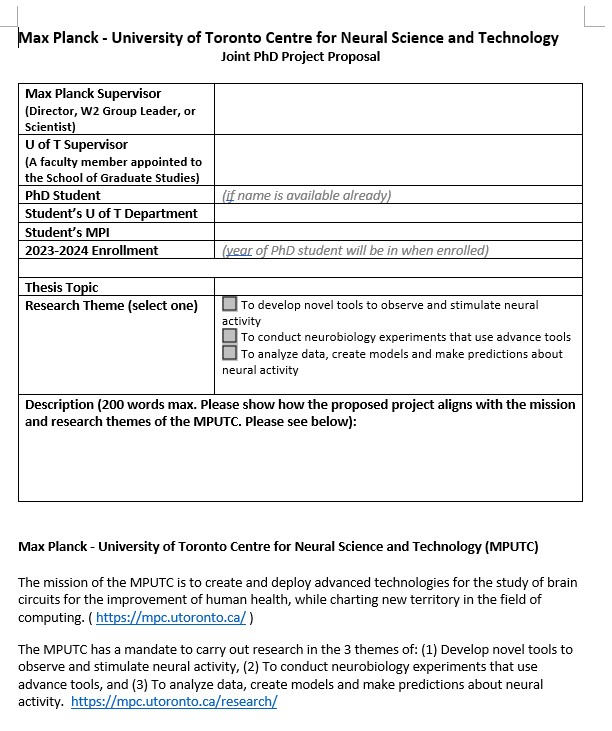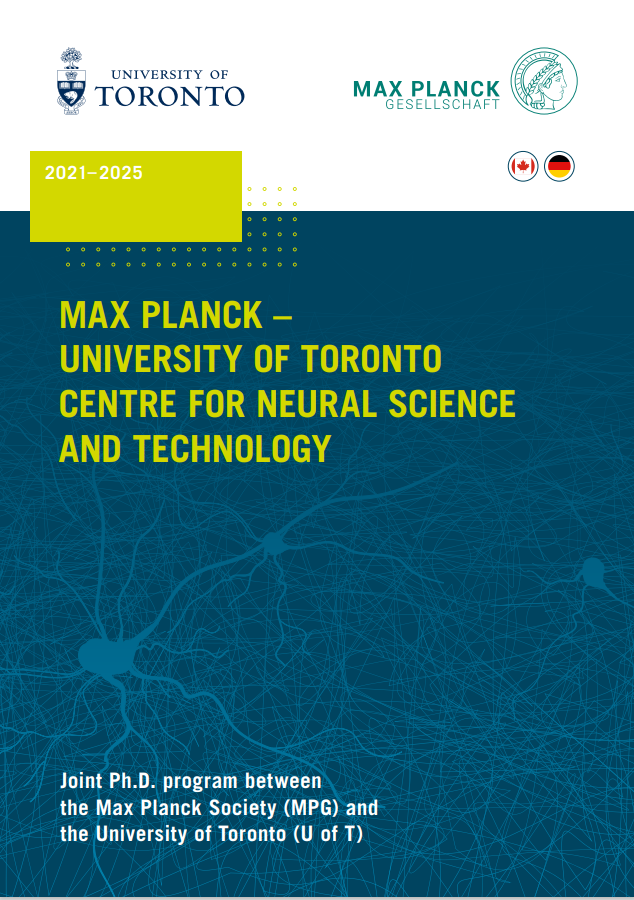MPUTC Joint PhD Program
The Max Planck-University of Toronto Centre (MPUTC) for Neural Science and Technology offers unique opportunities for jointly supervised PhD thesis research between the participating Max Planck Society (MPG) and University of Toronto (U of T) PIs.
How the Program Works
PhD candidates complete academic requirements at and earn PhD degrees from the U of T while being able to conduct research at a Max Planck Institute (MPI). As a jointly supervised PhD student, you will have access to complementary facilities, equipment, and diverse intellectual feedback to increase the impact of your research. The ability to work effectively at multiple institutions, with different cultures, and in international environments is an important and highly valued skill in the global economy. Finally, the experience will increase your job prospects as you expand your network, meet new friends and colleagues, and learn about different cultures.
Year 1 : U of T
Coursework, get started in research, pass qualifying exam.
Year 2 & 3 : MPI
Research, visit U of T as necessary
Year 4 : MPI & U of T
Research, visit U of T as necessary
Defend thesis at U of T
Funding
- At U of T: PhD students receive funding according to the registered department's policy. ( MPUTC International Doctoral Cluster Award or stipend of $18,000+ also available for students supervised by PIs in the Faculty of Applied Science and Engineering (BME, ECE, ChemE, MIE), Institute of Medical Science, Krembil Brain Institute, and Hospital for Sick Children.)
- At MPI: PhD students receive a minimum of 65% TVöD (German civil servant salary scale) 13 work contract at the project-affiliated MPI.
How To Register
Check the available projects below for a collaborative PhD position between a participating MPG PI and the U of T PI.
Alternatively, you may contact one of the participating PIs directly to see if they can create a project:
University of Toronto PI's
Max Planck Society PI's
Mail For Inquiry
max.planck@utoronto.ca
- Submit a graduate studies application for the PhD program at the department of the University of Toronto supervisor. Please click the “How to apply for the PhD program” link under the “Student’s U of T Department” for details about the application.
- Send your CV and a 1-page single spaced proposal to the relevant supervisors and administrator to apply for an available project or request for a proposed collaboration.
The MPUTC is strongly committed to diversity within its community and especially welcomes applications from racialized persons / persons of colour, women, Indigenous / Aboriginal People of North America, persons with disabilities, LGBTQ2S+ persons, and others who may contribute to the further diversification of ideas.
Project proposal
To submit a proposal for a joint PhD project, please complete this MPUTC Joint PhD Project Proposal template. Successful applicants will be notified on an ongoing basis.
| Max Planck Supervisor (Director, W2 Group Leader, or Scientist) | Lucia Melloni |
| U of T Supervisor (a faculty member appointed to the School of Graduate Studies) | Kamil Uludag |
| Ph.D. Student | TBD |
| Student’s U of T Department | Medical Biophysics (How to apply for the PhD program) |
| Student’s MPI | MPI for Empirical Aesthetics |
| 2023-2024 Enrollment |
Thesis Topic : Specific Hippocampal pathways mediate episodic memory and statistical learning.
Description: The process by which new memories are layered upon prior experience and knowledge remains poorly understood. Growing evidence suggests that the hippocampus is critical for rapidly extracting regularities from the environment, a process known as statistical learning. These results, which imply generalization across episodes, are however at odd with the known role of the hippocampus in encoding individual memories. An extension of the complementary learning system accommodates this conundrum by postulating that episodic memory and statistical learning operate via different hippocampal pathways. Although this model provides a theoretical solution to a long-standing puzzle in the field, testing it in human subjects is technically challenging as it requires imaging the hippocampus with high spatial resolution to enable subfield classification and high temporal resolution to characterize the sequence of activity in the two pathways. We want to acquire unique datasets for this purpose by integrating 7T high-field fMRI with invasive electrophysiology, and electrical stimulation of specific hippocampal subfield in epilepsy patients while subjects perform associative learning and statistical learning tasks. This project seeks to establish a new multi-institution, high-throughput collaboration for large-scale, non-invasive imaging, invasive neural recording and stimulation to study memory processes in healthy subjects and patients.
| Max Planck Supervisor (Director, W2 Group Leader, or Scientist) | Metin Sitti |
| U of T Supervisor (a faculty member appointed to the School of Graduate Studies) | Eric Diller |
| Ph.D. Student | TBD |
| Student’s U of T Department | Mechanical and Industrial Engineering (How to apply for the PhD program) |
| Student’s MPI | Physical Intelligence |
| 2023-2024 Enrollment |
Thesis Topic : Microrobotic Electrode Placement for Neural Interfaces and Deep Brain Stimulation.
Research Theme: Develop novel tools to observe and stimulate neural activity.
Description: The project is part of a broader effort to develop micro/nanotechnology-based sensors and actuators to monitor and stimulate neural circuits in vitro and in vivo. The goal of the devices is to enable a better understanding of neurons and neural circuits, which will aid in the development of neuromedicine. The ability to map the activity of individual neurons will allow for high resolution recording of neural activity at a level not seen before. To this end, advanced probes are being developed to be implanted into brain tissue. However, the ability to place arrays of electrodes with single-neuron precision has not been achieved. In this project, the student will develop new electrode placement mechanisms based on smart material and/or magnetic actuation which allows for addressable precision placement of many electrode tips within an array. The student will work in the labs of Prof. Eric Diller at the University of Toronto and Metin Sitti at the Max Planck Institute for Intelligent Systems using multidisciplinary skills. With neurophysics collaborators, the student will develop prototypes for testing in phantom models to prove the efficacy for electrode placement and adjustment.
| Max Planck Supervisor (Director, W2 Group Leader, or Scientist) | Dr. Lars Meyer, Dr. Burkhard Maess |
| U of T Supervisor (a faculty member appointed to the School of Graduate Studies) | Dr. Björn Herrmann |
| Ph.D. Student | TBD |
| Student’s U of T Department | Psychology (How to apply for the PhD program) |
| Student’s MPI | Max Planck Institute for Human Cognitive and Brain Sciences |
| 2024-2025 Enrollment |
Thesis Topic : Leveraging artificial intelligence tools to characterize the perception of accented speech in older adults.
Research Theme: To conduct neurobiology experiments that use advance tools, and to analyze data, create models and make predictions about neural activity.
Description: Canada and Germany are immigration countries where individuals from different language backgrounds live together and communicate. This brings mutual challenges: Native and immigrant listeners routinely encounter non-native accents, while for immigrants it additionally is their second language, making speech comprehension difficult. This is a barrier to social participation especially for older adults: 1) 40% of adults over 60 live with hearing loss, making comprehension challenging, particularly for non-native speakers and accented speech; 2) >15% of adults over 60 live with cognitive decline, reducing their language proficiency and accented speech comprehension. The proposed work will leverage advanced data analysis tools with non-invasive brain recordings to develop a detailed account of how accented speech is processed in the brains of native and non-native speaking older adults. Participants will listen to naturalistic speech with different, non-native accents under different listening conditions (e.g., background noise). Artificial intelligence tools, including speech synthesizers and Large Language models, and modern deconvolution modeling will be used to understand how acoustic, phonetic, and semantic information are encoded neurally. The work will provide tools, approaches, and understandings for future clinical applications, such as detecting hearing loss earlier, detecting second language loss in adults with cognitive decline, and evaluating treatment outcomes..
| Max Planck Supervisor (Director, W2 Group Leader, or Scientist) | Dr. Mariya Toneva |
| U of T Supervisor (a faculty member appointed to the School of Graduate Studies) | Dr. John Griffiths |
| Ph.D. Student | TBD |
| Student’s U of T Department | Biomedical Engineering / Medical Sciences (How to apply for the PhD program) |
| Student’s MPI | MPI-SWS, Saarbrücken |
| 2024-2025 Enrollment |
Thesis Topic : TBD
Research Theme: To conduct neurobiology experiments that use advance tools.
Description: The fields of cognitive and clinical neuroscience have learned a great deal about the functional organization of the mind/brain using noninvasive imaging technologies such as fMRI, and M/EEG. Traditionally this research has required tightly controlled experimental lab conditions, with several non-naturalistic elements such as a requirement to remain still, seated/supine, quiet, in darkly lit rooms, and in the case of vision science observing contextually disconnected 2D images. New developments in mobile neuroimaging technologies, eye-tracking, and virtual+augmented reality (VR/AR) are enabling a new wave of investigations where the brain is studied in a substantially more naturalistic setting. In particular, the coupling of high-density mobile EEG with AR and eye tracking allows experiments where subjects move freely in their environment, and visual stimuli are presented virtually as navigable 3D objects. This project will explore this paradigm’s extension to mobile, high-density functional near infrared spectroscopy (fNIRS), recorded concurrently with EEG, adding an important complementary brain measurement modality. Using this approach, we will study the emergence and representation of semantics at different levels of abstraction in contextually-situated processing of visual objects, collecting fNIRS-EEG data and analyzing it with advanced statistical techniques, as well as neurophysiological and neuro-AI models.


